- Yokohama-shi Top Page
- Living and Procedures
- Community Development and Environment
- Green park
- Zoos and Botanical Gardens
- Preservation and Research Center, City of Yokohama
- Animals raised in Preservation and Research Center, City of Yokohama
- Preservation and Research Center, City of Yokohama breeding birds 1
Here's the text.
Preservation and Research Center, City of Yokohama breeding birds 1
Last update date April 1, 2024
Introduction of Kagu Bali Myna New Caledonian Imperial Pigeon
I would like to introduce Kagu, Bali Myna and New Caledonian Imperial Pigeon, which are bred in Preservation and Research Center.
Kagu Kagu
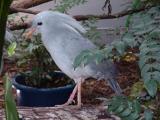
<scientific name> Rhynochetos jubatus
Kagu belongs to the EURYPYGIFORMES Category, but one species per genus, and there are no nearby birds. It is an endemic species that only lives on the South Pacific island of Grande Terre, New Caledonia.
It is about 55cm long and weighs about 1000g, and almost the whole body is covered with bright gray wings. There is a black wing belt on the wind kiri feather and the first line heavy rain cover, and brown spots in the center of the wind kiri feather. There is a long crown on the head, which is used for display purposes. The light color is red, and the beak and legs are orange-red.
There is no difference in size of male and female, and it is difficult to distinguish male and female in appearance. However, Kagu sometimes hears male and female loudly, and male screams have phrases that are not found in females, so it is possible to distinguish male and female by hearing this voice.
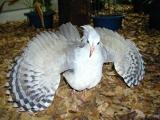
Kagu prefers dense and moist forest areas and forms a distinction for each pair. In the daytime, they walk around the forest floor to eat small animals such as earthworms and snails, and at night they stop on low tree branches and sleep. There is almost no flying force.
Wild Kagu mainly has spawning season from June to December. Create a nest like a pile of fallen leaves on the ground, and lay only one egg on it. Eggs have brownish brown and black or brown spots, and have a protective color that is hard to distinguish from fallen leaves. The incubation takes turns by male and female and hatches in about 33 days. The born chicks are covered with burnt brown feathers and can be stood and walked, but stay in the nest for a few days and grow with feeding from the parent bird.
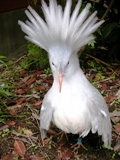
It is said that the Kagu used to be distributed throughout the island, but the colonization of New Caledonia began in 1853, with deforestation for nickel mining and ecosystem disruption caused by dogs, cats, pigs and rats imported by Europeans, etc. It is said that the population has dropped sharply and temporarily dropped to about 100 birds. Therefore, among the three states governing New Caledonia Birds Association and New Caledonia, the Southern State Government began full-scale conservation activities in 1977. As a result, we recovered approximately 600 birds in the current protected area of Parc provincial de la Riviere Bleue and an estimated 1,000 birds in New Caledonia as a whole.
At the zoo in Yokohama, a pair of Kagu was donated by the Southern State Government of New Caledonia in 1989, and has been successful in breeding under breeding. It was then exported to Weltvogelpark Walsrode in Germany and San Diego Zoo in the United States in 1997, and began full-scale efforts to live Ex situ conservation.
In Japan, it is currently bred only in Nogeyama Zoological Gardens and Preservation and Research Center, City of Yokohama.
Bali Myna Bali myna
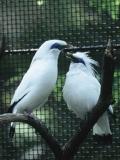
<scientific name> Leucopsar rothschildi
Bali Myna is a starling peculiar to Bali in Indonesia, with a total length of about 25 cm and a weight of about 120 g.
Adult birds have white feathers, and only the tip of the first row wind kiri feather and the tip of the tail feather are black. The naked part of the skin around the eyes, which is often seen in southern starlings, has a bright cobalt blue color. It is relatively difficult to distinguish male and female from the appearance of male and female, but males are slightly larger than females and tend to develop crowns and beaks. It is often observed that the male and female cannot be distinguished by this action, because the male and female is performed together.
Bali, where Bali Myna lives, has a dry monsoon climate with rainy season from December to April, and dry season from June to October. There is almost no change in temperature throughout the year, and the average annual temperature is around 28 ° C. The Bali Myna inhabits the savannah forest, which is full of shrubs along the coast, and cannot be seen in high altitude areas.
In the wild, insects and small animals feed, but there is also a strong tendency to eat fruit, especially during the dry season, it has been observed that fruits are collected in groups or pairs.
The breeding season is from January to March, which is the rainy season, and usually only breeds once on a pair. Nests are made by collecting dead grass and twigs in tree caves. The clutch size is 2 to 4 eggs, and it is said that only one breeding in the wild grows in one breeding, but it is not uncommon for two or more chicks to nest under breeding.
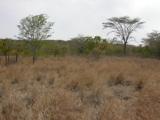
Bali Myna was discovered in 1911, and since its discovery, its habitat was limited to the northwest coast of the island, with a small population. In the 1960s, it was overgrown as domestic birds due to the deforestation due to agricultural development and its beauty, and the wild population estimated to be 200 in the 1970s fell below 100 in the mid-1980s. It became.
The western part of Bali, which was the habitat of the Bali Myna, was designated as the Bali Balato National Park in 1982, but the number of wild animals continued to decrease, reducing the number to 14 in 1990, and in the latter half of 2006, no longer visible in the wild.
On the other hand, more than 700 birds are bred in zoos in Western Europe, the United States, and Japan, and under breeding plans based on pedigree management are underway. In Indonesia, in addition to zoos, there are many cases where individuals own this bird. However, breeding Bali Myna, a protected bird, requires national permission, so it is often illegal breeding. Therefore, it is not possible to fully understand the actual situation of how many are bred, and one theory states that 500 or 1,000 birds are said to be.
In 1987, the Ministry of Forestry in Indonesia, the International Federation of Birds Protection, the Association of Zoos and Aquariums(AZA) and the Jersey Zoological Park of the United Kingdom collaborated to launch the Bali Myna Conservation Project. This was intended to monitor, maintain and improve the environment of Bali Balato National Park, the only habitat of Bali Myna, and to restore the population by returning the breeding population to the wild.
After that, in the national park, we worked on breeding and breeding using the remaining facilities, and resumed the wild return project using the increased individuals. In the eight years from 1998 to 2005, 82 birds were released, and at the end of 2007, about 60 birds were released. In Nusa Penida, located on the east side of Bali, there are reports that individuals bred by individuals were released outdoors in 2007.
New Caledonian Imperial Pigeon New Caledonian Imperial Pigeon
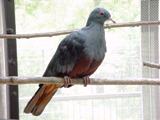
<scientific name> Ducula goliath
New Caledonian Imperial Pigeon is a pigeon that lives only in New Caledonia, an island in the South Pacific, and local name is called notou. It is distributed in Isle of Pines, adjacent to Motojima New Caledonia, but the population of Isle of Pines is small. With a total length of about 50 cm and a weight of about 700 g, it is said to be the largest tree pigeon in the world. The upper surface of the body is grayish black, blue-grey from the head to the chest, reddish brown in the abdomen and the center of the tail feather, puff-colored in the luminous color of the male and female, and there is no apparent gender difference.
This species inhabits the high canopies of the forest of New Caledonia alone or in several birds, and mainly feeds plasma fruits. They sometimes eat leaves and flowers, and they often stay still on the tree except when moving and eating time, and rarely descend on the ground. The breeding season is from June to December, nests with a thickness of 8 to 15 cm and a diameter of 30 to 40 cm on trees over 15 m above the ground, and usually lay one white egg. Incubation and breeding chicks are carried out by male and female.
In the past, it seems that many inhabited the entire island, but the forest that inhabited by deforestation for nickel mining has been lost, and in recent years the population has become extremely small due to hunting. At present, New Caledonian Imperial Pigeon is said to be home to about 6,000 to 7,000 birds in the protected area of Parc provincial de la Riviere Bleue. However, despite legal regulations, it is still subject to hunting, which poses a major threat to the survival of the species, and is designated as a near-endangered (NT) in the Red List of IUCN.
Inquiries to this page
Yokohama Green Environment Bureau Park Green Space Division Zoo Division Preservation and Research Center
Telephone: 045-955-1911
Telephone: 045-955-1911
Fax: 045-955-1060
Email address: mk-hansyoku@city.yokohama.lg.jp
Page ID: 749-865-727







